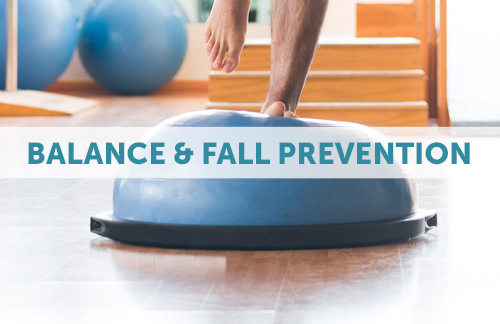Vestibular Rehabilitation
It is estimated that 35% of adults aged 40 years or older in the U.S. have experienced some sort of vestibular dysfunction — approximately 69 million Americans
Dizziness and disequilibrium are second only to low back pain in the frequency of occurrence in the adult population. Balance and vestibular deficits are a major medical concern, and the resulting effects of an untreated balance disorder can be devastating. The good news is that in many cases a physical therapy treatment plan can successfully treat the problem, preventing subsequent injury.
Vestibular Disorders That Respond Well to Physical Therapy Treatment:
- Benign Paroxysmal Positional Vertigo (BPPV)
- Meniere’s disease
- Migraine Associated Vertigo (MAV)
- Motion sensitivity
- Post-concussion syndrome
- Vestibular neuritis/labyrinthitis
- Other musculoskeletal or neurologic disorders that result in balance or dizziness problems
Vestibular rehabilitation therapy is an exercise-based program designed to promote central nervous system compensation for inner ear deficits. A licensed physical therapist will be able to offer a variety of initial services to all patients experiencing dizziness and balance deficits.
More Information About Vestibular Rehabilitation

BPPV/Vertigo
Expand For More Info
Many people who suffer from acute dizzy spells can be helped by physical therapy. Benign Paroxysmal Positional Vertigo (BPPV) is characterized by a brief episode of vertigo (spinning) every time your head moves into a specific position. Common causes of this disorder are trauma to the head (concussion, motor vehicle accident, etc.) and acute infection, but frequently the cause is unknown. Patients usually complain of a spinning sensation being provoked by lying down, rolling over in bed, bending over, or looking up. Common activities that can provoke this sensation include getting out of bed, gardening, washing hair in the shower, and going to the dentist or beauty parlor.
Common Symptoms
- Vertigo: The perception of movement/spinning, either of the self or the environment
- Dizziness: General term that describes light-headedness, floating sensation, or faintness
- Imbalance: Disequilibrium is a feeling of being off-balance or a loss of equilibrium
Uncommon Symptoms
- Nausea
- Blurred vision
- Anxiety
- Lack of coordination
- Difficulties with memory and concentration
- Headaches/neck pain
How do you Know if you Need Vestibular Rehabilitation?
- If you feel unsteady
- If you lose your balance and fall
- If you feel like you are falling, the room is spinning, or get dizzy when you lay down
- If you feel like you are moving when you are standing or sitting still
- If you feel light-headed
- If you have blurred vision
- If you ever feel disoriented, such as losing your sense of time or where you are
- If you’ve been diagnosed with BPPV, labyrinthitis, vestibular neuritis, Meniere’s syndrome, migraine-related dizziness, or cervicogenic dizziness

What to Expect from Treatment
Expand For More Info
Physical therapists use exercises that provide small, controlled, and repeated “doses” of the movements and activities that provoke dizziness to de-sensitize and fine-tune the brain.
During a Vestibular Rehabilitation Program
Physical therapists provide comprehensive balance and vestibular rehabilitation programs. You will experience treatment protocols for specific diagnoses, with a focus on alleviation of symptoms and return of function.
Our goal for vestibular patients is to decrease feelings of vertigo and dizziness, improve balance, posture control, gaze stability, overall endurance, and conditioning, and increase safety during everyday activities.
Treatment for vestibular rehabilitation may include, but is not limited to:
- Oculomotor Exam
- Neuromusculoskeletal Exam
- Canalith Repositioning Maneuvers
- Habituation Exercises
- Balance Exercises
- Conditioning Exercises
- Functional Activities
- Patient Education
- Home Exercise Program
When you Visit:
- Wear comfortable clothes that allow you to move freely
- Bring a list of your current medications, especially those prescribed for your symptoms
- You may experience dizziness or an increase in symptoms initially. If possible, have someone with you for the first couple of appointments to assist you home if needed

Balance and Fall Prevention
Expand For More Info
After BPPV or other vestibular disorders have resolved, poor balance often remains. Retraining balance systems are effective in improving safety and independence whenever balance is compromised.
Fall Prevention Programs
Fall prevention programs offered by physical therapists are designed to increase independence with functional activities, functional mobility, and safety awareness while decreasing fall risk. Research has shown that a successful fall prevention program must be multi-dimensional. A program must address all underlying factors in addition to strength and balance.
Physical therapists use valid and reliable assessments to determine all the factors affecting each individual’s fall risk. Therapy focuses on reducing the factors and decreasing fall risk.

